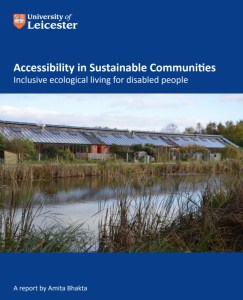 Why does the design of built environment continue to fail people with disability? Many have asked this question since Selwyn Goldsmith raised it in the 1960s. Many have found answers. But these are not enough to make a difference to the results. New buildings continue to pose barriers in spite of regulations and standards. Going beyond minimum standards is therefore a big ask.
Why does the design of built environment continue to fail people with disability? Many have asked this question since Selwyn Goldsmith raised it in the 1960s. Many have found answers. But these are not enough to make a difference to the results. New buildings continue to pose barriers in spite of regulations and standards. Going beyond minimum standards is therefore a big ask.
Imogen Howe, an architect with 10 years experience, wants to find the answer in her PhD study. Her research questions are something we can all think about:
-
- Why and how does the Australian built environment continue to marginalise people with disabilities, despite the Disability Discrimination Act (1992)?
- How does building design reproduce exclusion and segregation? How is this underpinned by design assumptions and approaches both contemporary and historic?
- Do building and design codes in Australia, NZ, Canada and the UK address dignity?
- How do we educate becoming architects about the need for inclusive design and then how to enact it in their designs?
References are made to key thinkers and writers on the topic such as Amie Hamraie, C.W. Mills, Joss Boys and Michel Foucault.
These questions are posed in an article framed as a discussion piece in Academia.edu. The key provocations for the discussion are: eugenics and stigma in design, society structures, and how could this be different. The title of the article is, “The need for inclusive design: going beyond the minimum standards in the built environment”.
Beyond compliance with universal design
 A guide book from Ireland on the built environment draws together Irish standards with a practical universal design approach. Many of the standards mirror those in Australia so most of the information is compatible. Parking, siting, pedestrian movement, steps, ramps, lifts, seating and bollards are all covered.
A guide book from Ireland on the built environment draws together Irish standards with a practical universal design approach. Many of the standards mirror those in Australia so most of the information is compatible. Parking, siting, pedestrian movement, steps, ramps, lifts, seating and bollards are all covered.
Building for Everyone, External environment and approach covers each of the features in detail. While the style of tactile indicators varies from the Australian design, the advice on placement is still useful. There is a reference list of related documents including Australian Standards. The guide is undated, but probably published circa 2010. This means some of the technology, such as parking ticket machines is a little outdated.
There is also a section at the end on human abilities and design. It covers walking, balance, handling, strength and endurance, lifting, reaching, speech, hearing, sight, touch and more.
Published by the Centre for Excellence in Universal Design in Ireland it is very detailed. Checklists help guide the reader through the material. This booklet links with others in the series, particularly the one on entrances and circulation spaces. The good aspect of these guides is the perspective of a universal design approach rather than proposing prescriptive design parameters.




 We expect to grow old, but because we don’t aspire to grow old, we rarely plan for it. “I’ll worry about it when the time comes” is a usual response. A report from AHURI looks at the housing situation for older Australians and some
We expect to grow old, but because we don’t aspire to grow old, we rarely plan for it. “I’ll worry about it when the time comes” is a usual response. A report from AHURI looks at the housing situation for older Australians and some  It is often said that older people want to stay put, but this may not be the case for everyone. A study from Berlin, Germany looked at this issue in depth. While some of the findings might be specific to Berlin,
It is often said that older people want to stay put, but this may not be the case for everyone. A study from Berlin, Germany looked at this issue in depth. While some of the findings might be specific to Berlin, Around 70% of people with dementia are staying in their home environments. They can continue with their everyday lives for many years in the community if they get a bit of help in the form of supportive urban design. To the rescue comes the
Around 70% of people with dementia are staying in their home environments. They can continue with their everyday lives for many years in the community if they get a bit of help in the form of supportive urban design. To the rescue comes the  Moonee Valley City Council in Victoria wanted to know how to make environments more welcoming. They commissioned a project to find out what design features are most important to older residents. The toolkit is the result of much consultation within local communities and shows how a few tweaks can make places more vibrant, supportive and accessible.
Moonee Valley City Council in Victoria wanted to know how to make environments more welcoming. They commissioned a project to find out what design features are most important to older residents. The toolkit is the result of much consultation within local communities and shows how a few tweaks can make places more vibrant, supportive and accessible.



 Can homes be both eco-friendly and accessible? If not, it means people with disability and older people are excluded from the benefits of an eco-home. Part M of the UK building regulations require a level threshold and a downstairs toilet. The Lifetime Home standard provides for more flexibility for adaptation. Accessible eco homes are possible with the help of designers
Can homes be both eco-friendly and accessible? If not, it means people with disability and older people are excluded from the benefits of an eco-home. Part M of the UK building regulations require a level threshold and a downstairs toilet. The Lifetime Home standard provides for more flexibility for adaptation. Accessible eco homes are possible with the help of designers 


 Retirement living has to factor pandemics into design now. Separation rather than isolation is the key. Much of the value of specialist retirement living is the easy access to amenities and socialisation. But the pandemic put a stop to both. The constant reminder that older people are more vulnerable to the infection was the last straw. Especially as everyone fell into the vulnerable category. Consequently, everyone got isolated from each other. But how to design for this?
Retirement living has to factor pandemics into design now. Separation rather than isolation is the key. Much of the value of specialist retirement living is the easy access to amenities and socialisation. But the pandemic put a stop to both. The constant reminder that older people are more vulnerable to the infection was the last straw. Especially as everyone fell into the vulnerable category. Consequently, everyone got isolated from each other. But how to design for this?